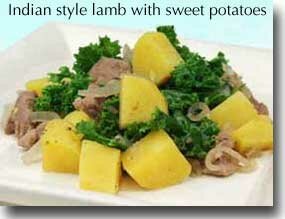Today's Recipe
If you don't know what to serve for dinner tonight ...
The blend of spices in garam masala in this recipe bring the unique taste of India to your Healthiest Way of Eating. Enjoy!
Indian Style Lamb with Sweet Potatoes

Prep and Cook Time: 30 minutes
Ingredients:
- 1 lb ground or minced lamb shoulder or leg
- 1 medium-sized onion, quartered and sliced thin
- 2 TBS minced fresh ginger
- 3 medium cloves garlic, pressed
- 1 tsp garam masala
- 5 cups finely chopped kale
- 3 cups sweet potatoes, peeled and cut in 1-inch cubes (about 1 large potato)
- 1 TBS + 1 cup chicken broth
- salt and white pepper to taste
- Prepare all the vegetables by chopping and have ready.
- Heat 1 TBS broth in a large-size stainless steel braising pot or skillet. Healthy Saute onion, garlic, ginger, and lamb in broth over medium heat for about 5 minutes, stirring frequently.
- Add garam masala*, mixing well for about half a minute. Add 1 cup broth and stir in sweet potatoes and kale. Simmer on medium low heat covered for about 15 minutes, stirring occasionally, or until lamb, potatoes and kale are tender. Season with salt and pepper.
- Marinated Beets
In-Depth Nutritional Profile for Indian Style Lamb with Sweet Potatoes
Healthy Food Tip
Do blueberries still provide strong antioxidant support after they have been frozen?
Yes, even after blueberries have been frozen, they can provide you with excellent antioxidant support. It's important, of course, for your blueberries to be high quality before they are frozen, and for this reason, I recommend organically grown blueberries that are firm and lively colored when purchased. Avoid blueberries that are dull in color or appear soft and watery. If purchased in a container, I recommend that you gently shake it to make sure that the blueberries are firm enough to move freely and independently.
I encourage you to pay special attention to the color of your blueberries because a large part of that color comes from the anthocyanins (antioxidant phytonutrients) in the berries. There's good research showing very little loss of anthocyanins after freezing of healthy, ripe berries so you'll hardly be losing any of these unique antioxidants if you properly freeze high-quality fresh berries.
For other antioxidant nutrients, the loss due to freezing varies from about 10-40%. You'll lose less than 20% of your berries' vitamin E, lutein, zeaxanthin, and beta-carotene from freezing, and that's plenty of reason to take advantage of freezing as a convenient way to enjoy blueberries even when they are out-of-season. The amount of vitamin C lost during freezing can vary widely and can be substantial, but I still recommend that you treat freezing as a very acceptable step when it comes to blueberries. While fresh blueberries still rank highest on my recommendation list, all of the trade-offs involved with frozen blueberries seem worthwhile to me. I would consider that you'd still be following the Healthiest Way of Eating if you go the frozen route when fresh berries are not available.



No comments:
Post a Comment